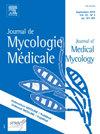溴喹啉通过抑制烟曲霉中蛋氨酸氨基肽酶对itc抗性突变体的新型抗真菌活性
IF 1.8
4区 医学
Q3 MYCOLOGY
引用次数: 0
摘要
背景:由抗唑曲霉引起的侵袭性曲霉病对公众健康的威胁越来越大,因此有必要开发新的抗真菌药物。我们进行了抗真菌化合物对唑耐药真菌的筛选和鉴定溴喹啉。我们的目的是研究其抗真菌活性和抗真菌机制。方法采用微稀释法对溴喹啉进行真菌药敏试验。采用复蓝素染色法检测溴喹啉处理后的细胞活力。采用棋盘法评价溴喹啉与伊曲康唑的协同作用。用分光光度法测定酶活性。通过结构分析、定点诱变和微尺度热电泳(MST)等方法确定了溴喹啉与烟曲霉甲硫氨酸氨基肽酶(AfMetAP)结合的关键氨基酸残基。结果溴喹啉对耐唑烟曲霉有一定的杀菌活性,并与伊曲康唑有协同作用。此外,我们通过与AfMetAP1的关键残基T279A/W280A和AfMetAP2的关键残基Y527A相互作用,发现溴喹啉是AfMetAP的强抑制剂,并且在体内,AfMetAP高表达的菌株对BQ具有抗性。结论溴喹啉对抗唑曲霉具有一定的抗真菌活性,是体外ITC增强剂。AfMetAP可能是生物靶点BQ在体内调节抗真菌活性。AfMetAP1的T279A/W280A和AfMetAP2的Y527A是维持溴喹啉与靶酶AfMetAP稳定相互作用的关键氨基酸位点。本文章由计算机程序翻译,如有差异,请以英文原文为准。
Novel antifungal activity of broxyquinoline against ITC-Resistant mutants via inhibition of methionine aminopeptidase in Aspergillus fumigatus
Background
A rising public health threat of invasive aspergillosis causing by azole-resistant Aspergillus species necessitates the development of novel antifungal agents. We performed a screening of antifungal compounds against azole-resistant fungi and broxyquinoline was identified. Our aim was to investigate its antifungal activities and antifungal mechanism.
Methods
Fungal susceptibility testing for broxyquinoline carried out by the broth-based microdilution methods. Cell viability treated by broxyquinoline was tested by resazurin dye testing. The synergistic effect of broxyquinoline and itraconazole was evaluated using checkboard assay. Enzyme activity was investigated with spectrophotometric methods. The key amino acid residues in the binding of broxyquinoline with A. fumigatus methionine aminopeptidase (AfMetAP) were indicated by structural analyses, site-directed mutagenesis, and microscale thermophoresis (MST) assays.
Results
Broxyquinoline has fungicidal activity against azole-resistant A. fumigatus and synergistic effects with itraconazole. Moreover, we discovered that broxyquinoline is strong inhibitor of AfMetAP through interacting with key residues T279A/W280A of AfMetAP1 and Y527A of AfMetAP2, and in vivo, the strains with high expression of AfMetAP are resistant to BQ.
Conclusions
Broxyquinoline has antifungal activities against azole-resistant Aspergillus spp. and is also a potentiator of ITC in vitro. AfMetAP may biologically targets to BQ in vivo regulating antifungal activity. T279A/W280A of AfMetAP1 and Y527A of AfMetAP2 are key amino acid sites to maintain stable interactions between broxyquinoline and target enzymes AfMetAP.
求助全文
通过发布文献求助,成功后即可免费获取论文全文。
去求助
来源期刊
CiteScore
5.10
自引率
2.80%
发文量
68
审稿时长
6-12 weeks
期刊介绍:
The Journal de Mycologie Medicale / Journal of Medical Mycology (JMM) publishes in English works dealing with human and animal mycology. The subjects treated are focused in particular on clinical, diagnostic, epidemiological, immunological, medical, pathological, preventive or therapeutic aspects of mycoses. Also covered are basic aspects linked primarily with morphology (electronic and photonic microscopy), physiology, biochemistry, cellular and molecular biology, immunochemistry, genetics, taxonomy or phylogeny of pathogenic or opportunistic fungi and actinomycetes in humans or animals. Studies of natural products showing inhibitory activity against pathogenic fungi cannot be considered without chemical characterization and identification of the compounds responsible for the inhibitory activity.
JMM publishes (guest) editorials, original articles, reviews (and minireviews), case reports, technical notes, letters to the editor and information. Only clinical cases with real originality (new species, new clinical present action, new geographical localization, etc.), and fully documented (identification methods, results, etc.), will be considered.
Under no circumstances does the journal guarantee publication before the editorial board makes its final decision.
The journal is indexed in the main international databases and is accessible worldwide through the ScienceDirect and ClinicalKey platforms.

 求助内容:
求助内容: 应助结果提醒方式:
应助结果提醒方式:


